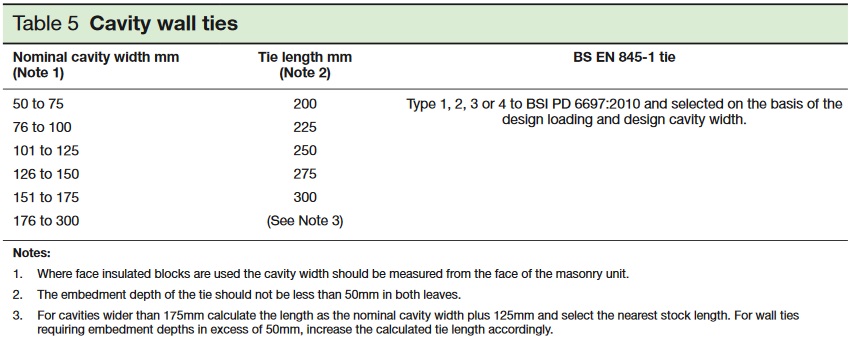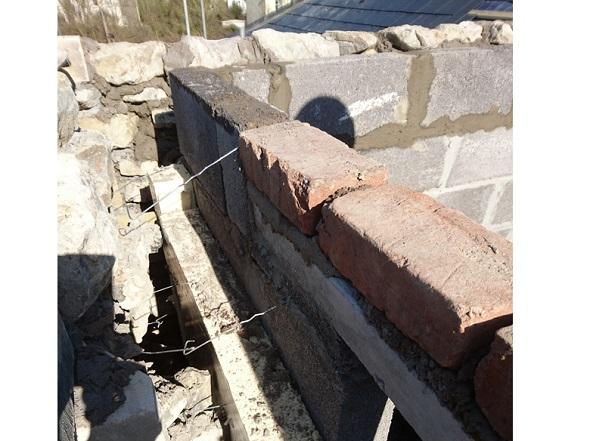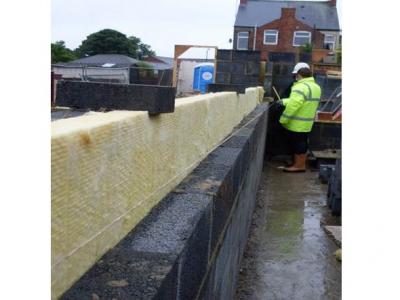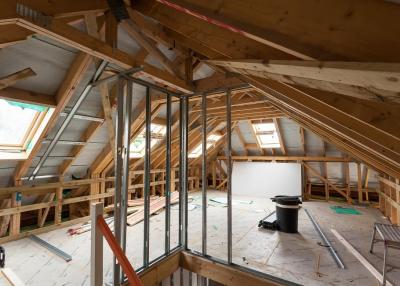How to use cavity wall ties correctly
Incorrect use of cavity wall ties is one of the common problems found on site by our building control surveyors. The wrong choice of cavity wall tie, not enough ties, and wrong detailing around openings are frequently spotted.
The image above shows how not to do it; hooking wall ties together, using masonry chunks to retain the insulation and not maintaining the cavity width will all lead to cold bridging and dampness. There’s no surprise that this wall had to be demolished and rebuilt.
Here are some easy steps to get your wall ties right:
- The length of wall tie needed is specified in table 5 of Approved Document A of the Building Regulations, reproduced below.

- You need two and a half wall ties per square metre of masonry. The maximum horizontal spacing is 900mm and the maximum vertical spacing is 450mm. That’s why cavity wall insulation boards usually have a maximum dimension on the short edge of 450mm.
- Set each wall tie a minimum of 50mm into both masonry leaves.
- Lay the wall ties to a slight ‘outward’ fall to prevent water passing to the inner leaf.
- Only use insulation retaining clips that are compatible with your tie.
- Change the wall tie pattern around openings such as windows, doors, roof verges and movement joints. Here the vertical spacing is reduced to a maximum 300mm and should be within 225mm of the opening. So realistically, that’s a wall tie every course of blocks within 225mm of the opening, which means you need to carefully cut (and clip) the insulation.
- Cavity wall ties should be stainless steel.
Follow these simple rules and you’ll meet the Building Regulation requirements every time.
Further reading
Also read Avoid backfalling wall ties
Please Note: Every care was taken to ensure the information was correct at the time of publication. Any written guidance provided does not replace the user’s professional judgement. It is the responsibility of the dutyholder or person carrying out the work to ensure compliance with relevant building regulations or applicable technical standards.
Sign up to the building bulletin newsletter
Over 48,000 construction professionals have already signed up for the LABC Building Bulletin.
Join them and receive useful tips, practical technical information and industry news by email once every 6 weeks.
Subscribe to the Building Bulletin



Comments
Pocket Door Cassettes
Submitted 4 years 8 months ago
Reply
Submitted 4 years 5 months ago
External pocket doors are available but the door runs parallel with the outside face of the external leaf. So it creates a clear opening but the door doesn't actually disappear into the wall cavity, it slides past the opening restrained by a framing system. That way the structural and weatherproofing aspects of the wall; wall ties lintel above, closed cavity, thermal bridges, seals etc aren't compromised.
Kind regards
David, LABC
Wall ties on DPC
Submitted 2 years 7 months ago
LABC Response
Submitted 2 years 7 months ago
Hi,
Thank you for your question.
LABC is a membership organisation, providing advice and support to its member local authorities around England and Wales. As a result, LABC cannot comment on the application and enforcement of the Building Regulations to a particular situation as this is a matter for the local council and ultimately the courts. Any general comment or guidance we do give should not be considered as legal advice or interpretation.
There is limited guidance on the use of wall ties at DPC level in both the Approved Documents and relevant British Standards. However, in my opinion, where possible wall ties should ideally not be positioned at DPC level. This will avoid the wall ties inadvertently damaging the DPC and/or DPM, and furthermore eliminates the possibility of the wall ties interfering with the DPC bonding to the masonry located directly below and above it.
Thanks,
LABC Team
Ancon wall ties
Submitted 2 years 6 months ago
LABC Response
Submitted 2 years 5 months ago
Kind Regards,
LABC Team
Wall ties below DPC
Submitted 2 years 1 month ago
LABC response
Submitted 2 years 1 month ago
Thank you for your comment. Cavity walls, regardless of whether they are above or below the damp proof course (DPC) level, need to be tied at the same spacings/distribution as elsewhere in the cavity wall. However, it is normal to either build with solid masonry, or to fill any cavity with lean mix concrete, to within 225mm of the DPC, in which case the first course of ties might be within/or at the level of the cavity fill concrete. We recommend that ties are not positioned on the DPC so as to prevent the possibility of it being accidentally punctured. As such the setting out of the 450mm high vertical spacing should be determined so that ties are not positioned on a DPC. Workmanship for masonry walls should be in accordance with BS 8000-3. The LABC article ‘installing cavity wall ties in masonry walls’ might be of some further interest.
Best,
LABC team
Ychwanegu sylw newydd